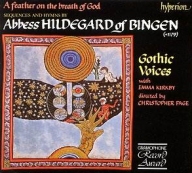


 Hildegard von Bingen was one of the greatest women of history. Born at the end of the 11th century and living into her 80s, Hildegard became Abbess of the nunnery at Bingen, but she was a person of many talents. Theology, music and poetry were amongst them, but she also became a famous woman of medecine and science, and as her fame grew she became advisor to kings and popes. She was also a talented brewer, and apparently the first person ever to add hops to beer. Then, perhaps because of the sexism of her society, and most of those since, she was largely forgotten until about 25 years ago, when her mystical writings started once again to become popular, followed by her music.
Hildegard von Bingen was one of the greatest women of history. Born at the end of the 11th century and living into her 80s, Hildegard became Abbess of the nunnery at Bingen, but she was a person of many talents. Theology, music and poetry were amongst them, but she also became a famous woman of medecine and science, and as her fame grew she became advisor to kings and popes. She was also a talented brewer, and apparently the first person ever to add hops to beer. Then, perhaps because of the sexism of her society, and most of those since, she was largely forgotten until about 25 years ago, when her mystical writings started once again to become popular, followed by her music.
 It's pushing 100°F in the Adelaide shade today. In nine days I'll be on a plane heading for Poland and I'm likely to see sub-zero temperatures. Those sort of temperature extremes take a toll on digital devices, and memory cards can be particularly vulnerable.
It's pushing 100°F in the Adelaide shade today. In nine days I'll be on a plane heading for Poland and I'm likely to see sub-zero temperatures. Those sort of temperature extremes take a toll on digital devices, and memory cards can be particularly vulnerable.
 Along with laptop computers and cellphones, digital cameras are surely one of the most stolen 'personal accessories'. Cellphones have IMEI numbers, SIM card locks and passwords. Computers have operating system passwords and BIOS level protection, and biometric security devices such as fingerprint scanners are currently coming onto the market. Laptops and cellphones are still stolen in vast numbers, probably because thieves know that most owners don't use the security features available, but at least owners are being offered options.
Along with laptop computers and cellphones, digital cameras are surely one of the most stolen 'personal accessories'. Cellphones have IMEI numbers, SIM card locks and passwords. Computers have operating system passwords and BIOS level protection, and biometric security devices such as fingerprint scanners are currently coming onto the market. Laptops and cellphones are still stolen in vast numbers, probably because thieves know that most owners don't use the security features available, but at least owners are being offered options.

 Seems like every second blog is talking about BlogExplosion. You know the kind of thing——"Hey, you should check out BE. It's really cool. I'm getting hundreds of hits a week. You should sign up. You really should. Blah-de-blah-de-blah".
Seems like every second blog is talking about BlogExplosion. You know the kind of thing——"Hey, you should check out BE. It's really cool. I'm getting hundreds of hits a week. You should sign up. You really should. Blah-de-blah-de-blah".

 Digicam manufacturers all rave about how their latest cameras are 'PictBridge' enabled. Yup, you can print directly from your camera to your PB enabled printer without turning on your computer for a single solitary moment, not even a little bit. Sure my computer's on all the time anyway. Sure, I am completely opposed to plugging cables into my expensive digicam because once you stuff up the weedy little connectors your entire camera becomes a paperweight. PictBridge is really exciting technology, right?
Digicam manufacturers all rave about how their latest cameras are 'PictBridge' enabled. Yup, you can print directly from your camera to your PB enabled printer without turning on your computer for a single solitary moment, not even a little bit. Sure my computer's on all the time anyway. Sure, I am completely opposed to plugging cables into my expensive digicam because once you stuff up the weedy little connectors your entire camera becomes a paperweight. PictBridge is really exciting technology, right?








They say you can tell a man by the company he keeps. If, for example, he keeps a company like Microsoft he'’s probably a very wealthy cybergeek, and I'’d be inclined to call him ‘'Sir'’ or ‘'Your Majesty'’ in the hope of handouts.
I'’m sure you can learn a lot about a man from his car as well. More than that, you can tell how he would like to be seen, and perhaps how he sees himself. A red open-topped sports car driven by a short, balding, spread-waisted fugly with a Hawaiian shirt, flaunting a hairy chest, medallion and one arm outside the car makes me think ‘'mid-life crisis'’ with some surety. When I see a Japanese family sedan with spoilers, skirts, bonnet scoop, 35 profile mags and large exhaust, 4 foot driver reclined in seat so as to appear 3 foot, and '‘boof boof’' music blaring from the stereo, I make a mental note to thank God I didn'’t have daughters.
So what of Seiko's and Pulsar'’s latest ads for watches? The Seiko ads suggest things like:
“It’'s not your car. It’'s not your friends. It'’s not your job. It’'s your watch that says most about who you are.”
I think what tells me most about a man is his demeanour, attitude, the way he talks and what he says. That much seems pretty obvious. As result these ads seem to have elicited quite a deal of criticism. But I think you can also tell a fair amount about the inner book from the cover, and I for one do use a man’'s watch as one of the ways of formulating an impression of him at first meeting.
My journey in watches
My father was a Rolex man. A solid, unpretentious, slightly old-fashioned exterior hid a quiet flair and a taste for real quality. He looked after his two Rolexes, lovingly cleaning them, removing scratches and generally making them appear their best. In his final year or so he found wearing a watch started to annoy him, and thought about selling them, but first asked me if I'’d like them, and in particular, if I'’d wear them, After all, why own a classic car if it’'s never driven?
Well, I’'m a Longines man. Progressive, creative, into style though a little unreliable. But my father’'s watches were so much a part of him that I had to have them, and wear them I do when in a Rolex sort of mood. That’'s not often, but they each get to see the world a few times a year.
In my quest to find out what sort of man I was, I tried quite a few watches. An elegant old Swiss Universal was my first ‘'grown-up'’ watch, a hand-me-down from my father. It had a remarkable hand-made mechanism, but I was going through my teen geek years and wanted digital! An ugly but reliable Citizen digital (the first with an alarm) was a good school friend. An elegant Seiko looked the part, but lacked character and never gelled with me in the same way. A multi-function Omega Sensor Quartz was used by astronauts but died in the shallow end of a friend'’s swimming pool and had to be flown back to
All these watches came to me as '‘surprises'’ from Dad, and I have them all still, hidden in drawers and boxes. I don’'t know where they are exactly, but they’'re somewhere, and I will come across them from time to time, like old photos; chronometers which chronicle my life.
 From the first time I set eyes on a 1980s Longines Conquest, the watch apparently inspired by Charles Lindbergh, I realised I could not rest until I owned one, and 10 years ago a two-tone metal-banded model joined clan Conway. I’'d wanted the crystal back, but when I tried one it was just too fat for my delicate wrist, so it’'s the plain-jane model, and it does just fine. Reasonably accurate and elegant to this day (mine is not the VHP model illustrated and doesn’t have romans but is otherwise the same).
From the first time I set eyes on a 1980s Longines Conquest, the watch apparently inspired by Charles Lindbergh, I realised I could not rest until I owned one, and 10 years ago a two-tone metal-banded model joined clan Conway. I’'d wanted the crystal back, but when I tried one it was just too fat for my delicate wrist, so it’'s the plain-jane model, and it does just fine. Reasonably accurate and elegant to this day (mine is not the VHP model illustrated and doesn’t have romans but is otherwise the same).
Pulsar’s adverts
So Seiko, I'’m a believer in part, and I think your advertising is subtle and effective. It surprises me that some people are so inclined to literalise creative copy just so they can get hot under the collar. But if a watch tells us about the man, what was your subsidiary Pulsar thinking when they came up with these ads?
 Rather than letting the watch tell the tale, they’'ve decided to fill in the details for us, perhaps because wearing as Pulsar actually says '“Can'’t afford a Seiko, let alone a Swiss watch”'. The trouble is they tell us too much. I can relate to some of the oddities of these characters, but those to which I can'’t relate distance me from both the character and, ultimately, Pulsar watches.
Rather than letting the watch tell the tale, they’'ve decided to fill in the details for us, perhaps because wearing as Pulsar actually says '“Can'’t afford a Seiko, let alone a Swiss watch”'. The trouble is they tell us too much. I can relate to some of the oddities of these characters, but those to which I can'’t relate distance me from both the character and, ultimately, Pulsar watches.
Take Character 1. First, he’'s impossibly good looking, which would put many men off immediately. But whilst I can relate to his hatred of coriander and love of sandcastles and Dostoevsky, his passion for reality TV and Chihuahuas and his belief in ghosts mark him as shallow and superstitious, and lead me to the conclusion that he just keeps a copy of Crime and Punishment around to impress chicks, not because he can actually read. And I just don’'t like toy dogs.

As for Character 2, the one with the doped-up expression, I can relate to antique maps, steam typewriters, sci-fi and butterscotch pudding, and tolerate the kilt. But not having a mobile phone paints him as a Luddite, wanting six children suggests he is socially irresponsible and clueless about parenting (I mean, does he look fatherhood material?). And owning 27 pairs of jeans? Well, it’s not like me to be judgmental or anything, but what a loser!
I’'m sure we all fancy ourselves as individuals, so the idea of marketing watches as a means of individual expression is a perfectly good one, and it works for Seiko. But as soon as the individual becomes a weirdo, loony or loner then the advertising is doomed to failure. It’'s a fine line, and although I'’m sure Pulsar has a fine line of watches, they seem to have crossed to the wrong side of the line in marketing.
Women’s watches
You'’ll notice I’'ve focused very much on men and men's watches here. Frankly, like most men, I just can'’t understand women'’s watches. So often they are tiny braceletty things with eccentrically shaped faces and convoluted bands which go equally well with any clothing because they go with absolutely nothing. Oh look, are those hands? I can just make them out with the naked eye—remarkable. But where are the markings?
I’'ve resigned myself to the fact that the women’'s watches I like are never the ones my partner likes. Like women and neckties, it is a brave man who buys a watch for a woman. At the end of the day, if watches can tell you a little about a man, they can also speak volumes about how little men understand women.
Why watches?
So why do some of us have this fascination with watches? Is it because they are a permanent reminder of our link to history and the future, a meeting point between the temporal and the ephemeral? Do we form some subconscious relationship between the human pulse and the ticking of a watch? Is it simply because they'’re the gadget with which we spend the most time?
What do you think? And what sort of watch are you?

 New York correspondent Phillip Coorey is quoted in the Adelaide Advertiser as saying:
New York correspondent Phillip Coorey is quoted in the Adelaide Advertiser as saying:

 A few hours before Americans go the polls, Australians go to the races. Of course, the US election is important and all, but the Melbourne Cup is really serious. For 10 minutes on the first Tuesday afternoon of each November, every Australian workplace and shop comes to a standstill to watch Australia's richest horse race. And despite the fact that everyone's suddenly a horse-racing expert, bookies and totalizators across the country nevertheless rake in money at a canter. Expect over A$100 million to be bet this year in a country of only 20 million people.
A few hours before Americans go the polls, Australians go to the races. Of course, the US election is important and all, but the Melbourne Cup is really serious. For 10 minutes on the first Tuesday afternoon of each November, every Australian workplace and shop comes to a standstill to watch Australia's richest horse race. And despite the fact that everyone's suddenly a horse-racing expert, bookies and totalizators across the country nevertheless rake in money at a canter. Expect over A$100 million to be bet this year in a country of only 20 million people.


 On Sunday, Arsenal's unbeaten run came to an end at 49 games, and I am in mild mourning. Logically, it couldn't go on forever, and it's the greatest domestic success by an English team since the beginning of English league football in 1863. The previous longest unbeaten run was a mere 42 by Brian Clough's great Notts Forest side of the 1970s. The only other team ever to go through a season unbeaten was Preston North End in 1888/89, when the season was only 22 games, rather than the 38 we have today.
On Sunday, Arsenal's unbeaten run came to an end at 49 games, and I am in mild mourning. Logically, it couldn't go on forever, and it's the greatest domestic success by an English team since the beginning of English league football in 1863. The previous longest unbeaten run was a mere 42 by Brian Clough's great Notts Forest side of the 1970s. The only other team ever to go through a season unbeaten was Preston North End in 1888/89, when the season was only 22 games, rather than the 38 we have today.


It's time for a little tough love, people: Anyone who types in all lowercase needs to be taken out back and beaten. You are not e.e. cummings; you are not being "artistic." You're just too lazy to hit the shift key. If you can't be bothered with the extra keystroke, I can't be bothered to read your site.Go girl! Fellow bloggers, when I read your blog there is a conduit between what I am reading and what you were writing. It's made up of words, grammar, punctuation, page design, and so on. The clearer you can make that conduit; the less congested by bad spelling, abbreviations, and dots, the more I can connect with you, and isn't that your goal?


I am usually the last one out of a movie theatre who isn’t being paid attendance money. Having a friend in the film-making business encourages me to pore over every word of the credits, savouring every funny name and future legend.
So it came as a surprise to see several groups still debating ‘Peter Sellers’ as I rose to my feet. They clearly were not discussing the merits of the film, as that, alas, would have been a fairly short topic of conversation. A little eavesdropping led me to the conclusion that they were instead discussing the accuracy of several aspects of the tale.
And let’s be clear, this is a tale, rather than a biographic film. It starts at the end of Sellers’ ‘Goon Show’ years, when I would really have like to see the background to how he came to be there, his relationships with Milligan, Seacombe et al. It then presents a theory of Sellers’ life which can be pretty well summarised in two sentences. I can just about picture it in my TV Guide now—“Peter Sellers was a flawed comic genius whose character was shaped by his domineering mother. He was therefore bereft of actual character, existing largely in a miasma of invented characters, both on and off screen, leading to a series of failed relationships, dependence on a charlatan psychic and his ultimate death from a dodgy ticker”.
Well, that’s a perfectly good theory, but it’s all a bit simple. One only has to look at Sellers’ improvisation in the Goons, Lolita or Strangelove to realise that he was a very rare sort of genius indeed, and I for one would rather have a wider picture of his life and come to my own conclusions, rather than have an interpretation of a man whom I have related to in film over many decades thrust upon me. In a sense this is a myopic biopic and manipulative to boot.
Sure, director Steve Hopkins tries to make the journey interesting. Reality and film sometimes blur into an attempt at stream of consciousness. Like a Sellers film, Geoffrey Rush moves in and out of Sellers various persona, and also those of key players in Sellers’ life. It’s a valiant attempt, but ultimately it’s all a bit to obvious and indelicate. To me, the artifice of a film should be like a skeleton—I want to know it’s there, but I’d rather not see it all the time.
What nearly saves this film is the performances. Geoffrey Rush is perfectly cast and shows real versatility, particularly in the excellent recreations of vignettes from Sellers’ films. He is ably supported by Emily Watson as first wife Anne, Sonia Aquino as Sophia Loren and Charlize Theron who is spot on as Britt Ekland and continues to grow in stature as an actress, as well as being pleasant to look at. John Lithgow overacts horribly as Blake Edwards, which makes him just about perfect from my recollection (what did Julie Andrews ever see in that man?) and Stephen Fry tries to play Oscar Wilde again, but in the wrong movie. Frankly the film would have been better (and shorter) without his character.
But even fine performances are not enough to make this a good film. It is ultimately too deliberate and too obviously manipulative for that. And the clever vignettes recreating actual Sellers’ films actually made me want to rush out of the theatre to borrow those Sellers originals rather than prolong the agony much longer. For a true Sellers fan this film will be disappointing, but one will have the satisfaction of the self-importance which comes through recognising many of the filmic references. For the person unfamiliar with Sellers’ work, it will hold no interest whatsoever. Whichever camp you are in, rush to your video store and demand a copy of Dr Strangelove. It will teach you much more about Sellers’ confused comic genius than any myopic biopic.
Opinions expressed within this blog are not necessarily those of the author, as he is known to vacillate, and may deny all knowledge if asked about it in the future. However, that disclaimer doesn't apply to this Disclaimer, of course. Opinions expressed in this Disclaimer are definitely the view of the author, except when they very clearly are not. Got it?
If you read anything on this blog, you are entirely responsible for any deleterious effects which may result in you or others of any species, known or unkown, real or imagined. You are licensed for the non-commercial use of any material from this blog as long as proper attribution and notification is given. The author reserves the right to withdraw such licensing at the merest whim should he not like the way you use his stuff. Commercial use may be negotiated. Pretty easily, in fact. You wanna pay me, who am I to argue, right?